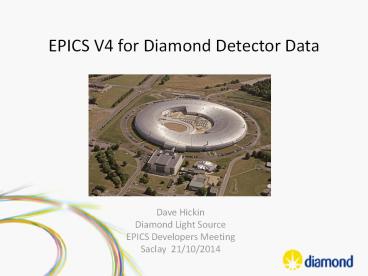EPICS V4 for Diamond Detector Data - PowerPoint PPT Presentation
1 / 23
Title:
EPICS V4 for Diamond Detector Data
Description:
Objectives. Lossless high-performance transfer of detector data and camera images including metadata. Software infrastructure to support it. Framework for high ... – PowerPoint PPT presentation
Number of Views:67
Avg rating:3.0/5.0
Title: EPICS V4 for Diamond Detector Data
1
EPICS V4 for Diamond Detector Data
- Dave Hickin
- Diamond Light Source
- EPICS Developers Meeting
- Saclay 21/10/2014
2
Objectives
- Lossless high-performance transfer of detector
data and camera images including metadata - Software infrastructure to support it
- Framework for high performance scientific data
services - Incremental development
- Based on areaDetector
3
Why transfer detector data?
- Transferring data between platforms(Usually from
Windows to Linux) - Cameras often have Windows only support
- Better support for HPC in Linux, e.g. HP file
system - Linux toolchain
- Preference for Linux (open source, reliability
etc.) - More expertise on Linux
- Distributing processing
4
Case Study I12 Beamline
- I12 Beamline at Diamond
- Joint Engineering, Environmental and
Processing(JEEP) - Imaging, Tomography, X-ray diffraction, SAXS
- PCO detector, Windows-only support
- HDF5-writer, Lustre distributed files system
- 90 10MB images per second
- 10 Gig Ethernet
5
Why use EPICS V4
- EPICS V4 adds structured data. Allows metadata to
be kept with image data - Image dimensions
- Colour attributes
- Experiment and system metadata
- Compression/encoding information
- Integrates with other EPICS developments, e.g.
CSS.
6
areaDetector overview
- Provides a general-purpose interface for
detectors and cameras in EPICS - Easily extensible
- Supports wide variety of detectors and cameras
- High-performance
- Mechanism for device-independent real-time data
analysis
7
areaDetector overview (cont)
- Camera drivers inherit from base class ADDriver
- Drivers produces NDArrays
- Run plugins
- Plugins inherit from NDPluginDriver
- Connect to asyn port on a driver
- Consume NDArrays
8
NDArray
- 1-d type array of numeric type
- Dimension information
- ID and time stamps
- Attributes
- Also has Array Pool (but not part of data)
9
NDArray
- Dimension
- Converts 1-d array to N-d array
- Describes how array is part of larger array
- Has size, offset, reverse and binning fields
- ID and timestamps
- Unique ID integer unique to frame
- Time stamp (from driver)
- 2nd time stamp
10
NDArray
- Attributes
- A linked list of heterogeneous type.
- Each attribute has name, description, source,
source type and value - Source type can be driver, parameter library,
EPICS PV or user-defined function - 2 standard attributes colorMode and Bayer
pattern. Color Mode turns 3-d array into 2-d
colour image - Attributes can describe image, contain info such
as camera parameters or current value of PV
11
areaDetector and EPICS V4
- areaDetector runs a plugin which is a pvAccess
server - Plugin translates NDArrays into EPICS V4
structured data (normative type). Closely maps to
NDArray - pvAccess used to transfer data
- V4 client implements ADDriver
- Translates V4 type back into NDArray
- Passes NDArrays to plugins
- Existing plugins run remotely
12
EPICS V4/AD Development
- EPICS V4 Initial Prototype
- Server-side plugin and client-side driver
- Uses pvAccess and EPICS V4 core code
- Client monitors PV
- Linux only. Not running on Windows yet
- Initially coding based on pvAccess testServer
- Further development
- Turn into robust solution
- Integrate with other developments
- Enhancements
13
EPICS V4 Server and Client Prototype
14
Prototype Images
15
Recent Work
- Increased performance. Tested on 10 Gig Ethernet
- Investigation and implementation of compression
- Server-side plugin uses pvDatabase instead of
testServer and new client written - Improved reliability. Helping to debug EPICS V4
core - Defined new normative type (NTNDArray) to replace
old type (NTImage) - CSS integration and pvaSrv
- Prototype V4 SimDetector
16
Compression
- Compression algorithm applied to image data
- Add compression info to V4 structure
- Allows effective bandwidth to exceed physical
- Used freely available compression libraries.
- An LZ4 library
- Blosc (multi-threaded compression)
- Combined LZ4 algorithm with Blosc
17
Performance on 10 Gig Ethernet
- Setup
- 2 High Performance Linux PCs, connected by direct
fibre 10 Gig Ethernet - SimDetector (modified) producing 3192x3192 images
running V4 plugin on one machine - V4 client driver on other machine running stats
hdf5 and mpeg plugins
18
simDetector Image
19
Performance on 10 Gig Ethernet
- Uncompressed
- 120-122 frames per second (97-99 bandwidth)
- Compressed
- With compression image reduced to 36 of original
size using lz4 and 38 by Blosc - Single threaded compression reduces performance
- Blosc-based compression (multithreaded) increases
rate - Blosc lz4 best. Up to 230 frames per second
(190 of bandwidth)
20
NTNDArray
- EPICS V4 structure for detector data
- Normative type
- 1 NTNDArray gives 1 frame
- Maps closely to NDArray
- Dimension data, time stamps, uniqueId, attributes
- Adds codec information
- Uses unions for image data and attribute values
- Uses structure arrays for dimensions and
attributes
21
V4 SimDetector
- Prototype V4 SimDetector
- Puts image direct into V4 structures instead of
NDArray. Publishes image as PV - V4 areaDetector client monitors and runs plugins
- Clients can run remotely or locally in the same
or different process - V4 can provide many of the functions provided by
areaDetector (monitor queues, reference counted
arrays)
22
Current and near future work
- Complete move to NTNDArray from NTImage
- Move to GitHub Module - ADPvAccess
- Package and release
- Integration with other EPICS developments
especially CSS - Windows build
- Deploy on beamline (I12 is candidate)
23
Possible future development of areaDetector/V4
- Group images from multiple detectors into single
image - Modify areaDetector drivers to put images
directly into NTNDArrays instead and plugins
consume these. - Other compression options
- Alternatives GStreamer































